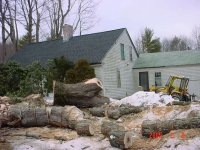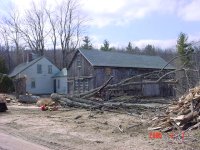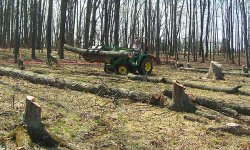Pilot
Veteran Member
- Joined
- Nov 20, 2004
- Messages
- 1,219
- Location
- Oregon
- Tractor
- JD 770, Yanmar 180D, JD 420 (not running), had a Kubota B6200
Falling with a chain saw is done as follows:
1. Clear an area around the tree to give you an escape route. If you can, prune some branches so that you can be certain the heavy side of the tree is on the side you want it to fall on.
2. Make your undercut (wedge) about 1/3 of the way through. Much more & you risk it breaking off and going in an unpredictable direction. Some species are more likely to do this than others.
3. Make your backcut most of the way through, leaving an inch or so of hinge wood. The hinge wood controlls the fall. Make both sides of the hinge wood parallel, or as parallel as you can. The backcut should be a couple inches higher than the undercut. This leaves a little vertical wall between the two cuts, so that when the tree goes, the butt can't kick out over the backcut.
3. Keep looking up. Watch the breeze & the rocking of the tree. It will usually go on it's own if you are patient. You can hammer in some plastic wedges to insure it won't go over backward. Depending on the size of the tree, you can push on it by hand to make it go. If it doesn't go, cut some more on the hinge, working from the backcut side. Sooner or later it will go. When it does, go away from the tree perpendicular to the line of fall; you don't want to be on the opposite side from the direction of fall in case it kicks back.
If you rig a line to pull it in one direction, don't put a lot of tension on it--you could make it break before you are ready.
Richard Scott
Retired forester
1. Clear an area around the tree to give you an escape route. If you can, prune some branches so that you can be certain the heavy side of the tree is on the side you want it to fall on.
2. Make your undercut (wedge) about 1/3 of the way through. Much more & you risk it breaking off and going in an unpredictable direction. Some species are more likely to do this than others.
3. Make your backcut most of the way through, leaving an inch or so of hinge wood. The hinge wood controlls the fall. Make both sides of the hinge wood parallel, or as parallel as you can. The backcut should be a couple inches higher than the undercut. This leaves a little vertical wall between the two cuts, so that when the tree goes, the butt can't kick out over the backcut.
3. Keep looking up. Watch the breeze & the rocking of the tree. It will usually go on it's own if you are patient. You can hammer in some plastic wedges to insure it won't go over backward. Depending on the size of the tree, you can push on it by hand to make it go. If it doesn't go, cut some more on the hinge, working from the backcut side. Sooner or later it will go. When it does, go away from the tree perpendicular to the line of fall; you don't want to be on the opposite side from the direction of fall in case it kicks back.
If you rig a line to pull it in one direction, don't put a lot of tension on it--you could make it break before you are ready.
Richard Scott
Retired forester



